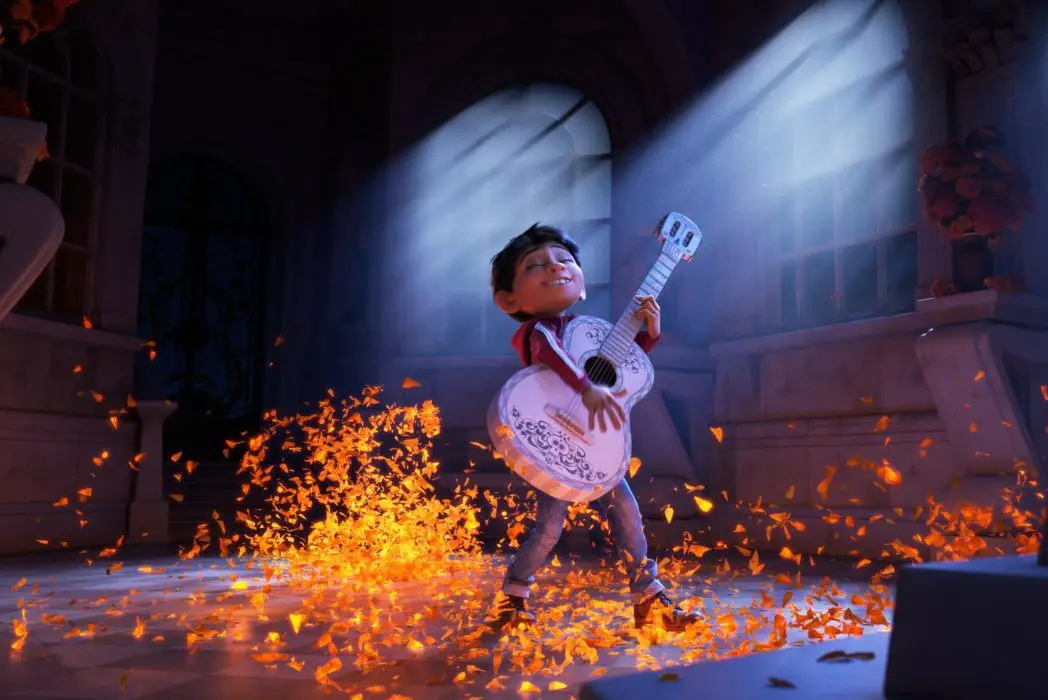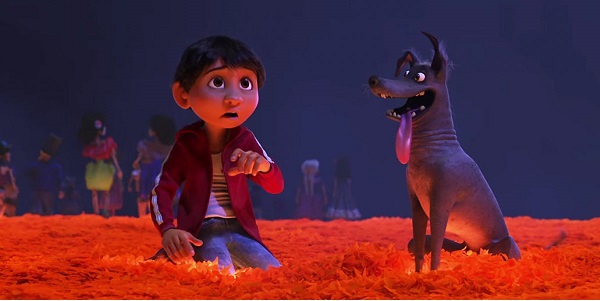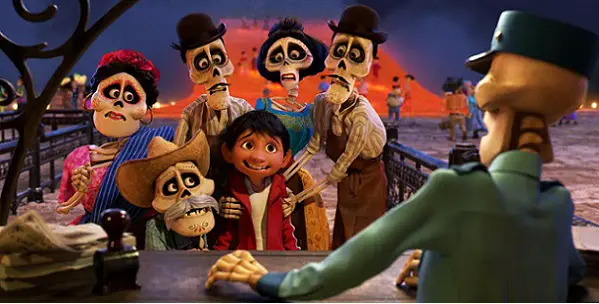COCO: A Masterpiece We Will Remember

Hazem Fahmy is a poet and critic from Cairo. He…
I saw Coco the day my brother left home to go back to San Francisco after Thanksgiving break. Already missing him on his way to the airport, I could not have been in a better mood to experience Pixar’s latest epic. Knowing the film would deal with themes of family and memory, a bedrock of my own heritage as an Egyptian, I knew I was in for an emotional romp, but I was not prepared in the slightest for just how much of a punch Miguel’s quest had packed for me.
The story opens on a family tale that has become borderline legendary. Our protagonist, the young and wide-eyed Miguel (voiced by newcomer Anthony Gonzalez), recounts how his family has banned music from their home for generations, ever since his great, great grandfather walked out on his wife and child in pursuit of fame of fortune. Heartbroken and betrayed, Miguel’s great, great grandmother cursed the memory of her husband and vowed to never honor neither his name nor his craft, turning to shoe-making to sustain her family.

Fast forward to the present, and the Rivera family continue to live off the thriving shoe workshop their ancestor had started. But Miguel feels compelled to pursue music, the very thing that supposedly cursed his family generations ago. After they discover his secret passion, his family urge him to reject music, as they have always done, and not follow in the footsteps of the disgraced patriarch.
Angry and tired of feeling misunderstood, Miguel breaks into the shrine of the legendary musician, Ernesto de la Cruz (voiced by the terrific Benjamin Bratt), who he believes to be his long lost ancestor, on the eve of Día de Muertos and attempts to steal his guitar. But as soon as he plucks the instrument, he finds himself transported to the fabled Land of the Dead, setting him up for one of Pixar’s most magical and unique journeys to date.
Film of the Dead
At the heart of Coco is arguably the most nuanced approach to death that I have ever seen in a children’s film. Here, dying is not be feared, at least not nearly as much as being forgotten. In everything but name, the film deals with neuroscientist David Eagleman’s notion of the Third Death, the idea that our “first [death] is when the body ceases to function. The second is when the body is consigned to the grave. The third is that moment, sometime in the future, when your name is spoken for the last time.”
Coco is especially interested in that last one, and centers love, especially familial, as the receipt from that final, total death. It’s profoundly refreshing to see a children’s film that doesn’t simply take the value of family for granted. For the characters we meet in the Land of the Dead, family is a literal source of life beyond death. Miguel is able to speak to his ancestors only because his family has done the work of keeping them alive through memory.
One of the most haunting scenes in Pixar history takes place when Héctor, the charming, down-on-his-luck skeleton (voiced by heartthrob Gael García Bernal) that Miguel befriends, shows the young boy where he lives, a slum at the bottom of the Land of the Dead, where souls that are not remembered reside. It is there that we meet Chicharrón (Edward James Olmos), Héctor’s old, bitter friend who is in the process of being forgotten. As the last person who remembers him dies, Miguel watches as Chicharrón fades before his very eyes, becoming a gorgeous gust of orange that disappears into the night sky. It’s a devastatingly poetic moment, one that anchors the emotional and thematic core of the film: your ancestors only die if you forget them.

This idea is, of course, central to the ethos of Día de Muertos, the inspiration and backbone for the film, and Pixar makes tremendous (and more importantly, respectful) use of the holiday’s cultural and philosophical context. When Coco was first announced, many were (justifiably) worried that the iconography of the sacred day would be little more than aesthetic props for the film, a mere source for the kind of bastardized ambiance we’ve grown accustomed to in American films that attempt to portray other cultures.
In fact, one of Coco’s greatest strengths is its deliberate breaking away from many of the frustrating clichés we’ve come to expect of Hollywood, especially in its portrayal of people and families, of color. By now, we’re all familiar with the deplorable trope of the oppressive ethnic family, a deeply damaging stereotype that’s been featured prominently from The Big Sick.
Throughout its various incarnations, the oppressive ethnic family trope uses stereotypes about families of color being close-minded and intolerant of individual liberty, and contrasts them with an American solution: pursue what you think will make you happy no matter what. Damn your family if they disagree. It’s a blatant call for American assimilation, one that demonizes cultural differences as backwards and irrational. Though the family usually comes around in the end and re-accepts the rebelling child, they must secede that everything they believed about the matter was completely false. There’s never a middle ground.
Family First
This is far from the case with Coco. The Rivera family’s vendetta against music is not born out of some draconian, inexplicable belief, but of a deeply embedded trauma that once threatened to fracture the very structure of the family. For good reason, Miguel’s family have come to view the pursuit of music as a vain and all-consuming one.
As far as they know, it was music, and its promise of fame and fortune, that once drove their patriarch to turn his back on everything he knew and abandon the family forever. Their fear of music is compounded by their observation that Miguel doesn’t just enjoy music, he’s obsessed with it, specifically with the ways it can make a myth out of a man.
They see in him that same fierce ambition that supposedly led his ancestor to abandon the family, and that rightfully scares them. When Miguel ecstatically claims that said ancestor must be de la Cruz, ignoring the pain and hardship he caused the family, it only confirms their fear that music has once again clouded the judgment of a member of the family, and that’s why they try to stop him.

So when Miguel’s abuelita trashes his personal sanctuary of de la Cruz, it doesn’t feel malicious in the slightest. Sure, it’s deeply painful to Miguel in the moment, but as the audience we understand why the family is going to such lengths to “protect” their child from music. Even when we later learn the truth about the disgraced patriarch and why he never came back, the film shows tremendous compassion towards the Rivera clan, both living and dead, and ensures that they don’t simply come across as an angry brown family desperate to control their children, as many American films commonly do.
The film doubles down on this understanding look at family when Miguel realizes that, just like his own folks, he too was misinformed, to a certain degree. Whereas most films that deal with the classic conflict between family loyalty and individual liberty tend to take a binary approach where one triumphs completely over the other, Coco achieves a graceful synthesis of the two values. In the end, Miguel doesn’t have to choose between his love for his family and his music. Rather, he finds a way to integrate these two great loves, using each to embolden the other. It’s an incredibly mature take on an archetypal story, one that resonates deeply with those of us who can never dispose of family, no matter how much we disagree.
Coco: Verdict
Charming, stunning, and heart-wrenching, Coco has swiftly joined the ranks of Pixar’s finest. When I returned home from the theater, I was overwhelmed with joy to see my family, and especially my grandmother. I’d always enjoyed her lengthy stories about her father and growing up in the fifties, but they suddenly had new meaning. Her stories were always worth listening to, but now I know, they’re worth remembering, too.
What would you like to see next from Pixar?
Coco is currently in theaters in the U.S. and the UK. For a list of full release dates, see here.
Does content like this matter to you?
Become a Member and support film journalism. Unlock access to all of Film Inquiry`s great articles. Join a community of like-minded readers who are passionate about cinema - get access to our private members Network, give back to independent filmmakers, and more.
Hazem Fahmy is a poet and critic from Cairo. He is an Honors graduate of Wesleyan University’s College of Letters where he studied literature, philosophy, history and film. His work has appeared, or is forthcoming in Apogee, HEArt, Mizna, and The Offing. In his spare time, Hazem writes about the Middle East and tries to come up with creative ways to mock Classicism. He makes videos occasionally.













